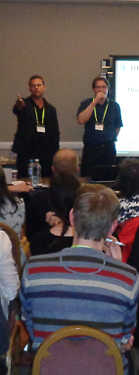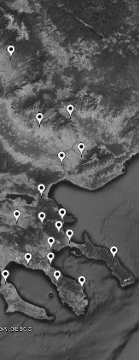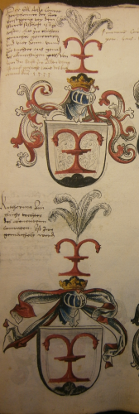|
|
|
|
|
|
|
|
Digitising Patterns of Power
Newsletter No.3 / September 2016
|

|
Dear Ladies and Gentlemen,
Dear Colleagues,
The participation of the project "Digitising Patterns of Power (DPP): Peripherical Mountains in the Medieval World" at the International Medieval Congress (IMC) 2016 in Leeds (UK) as well as at the 23rd International Congress of Byzantine Studies in Belgrade (Serbia) has furnished us with fruitful new experiences, comments, remarks and discussions.
In addition, two new case studies have been incorporated into our project, namely the case study on "The Herzheimer Family Chronicle (613-1506)" by Veronika Polloczek and "The Ethnonym of the Vlachs in the Historical Region of Macedonia (11th-16th Cent.)" together with the University of Skopje.
A special highlight was our first workshop held in Vienna at the Austrian Academy of Sciences on 28-29 September 2016, on which we will report in our next DPP Newsletter No. 4 (December 2016). Its aim has been perfectly achieved by the fact that international experts have expressed their ideas, comments and critique.
Yours sincerely,
the DPP team
|
|
|
|
|
|
|
|

|
DPP at the IMC Leeds 2016
|
The International Medieval Congress (IMC) 2016 at the University of Leeds took place from 4 July to 8
July. This congress is the largest of its kind in Europe and attracts around 2,000 historians from over
50 countries presenting over 1,700 individual papers. In 2016 our project Digitising Patterns of Power
(DPP) took part in the congress
with four consecutive sessions and 12 presentations.
Four of them were held by young academics, which facilitated their start into the international academic life.
Our lecturers presented their respective case studies within the project. All 12 presentations
were well attended by scholars with different academic backgrounds. Apart from the academic program
we had the chance to get in touch with several scholars and students from all over the world and
to visit the royal armoury, the largest museum of medieval weaponry in Great Britain. We all greatly
enjoyed the IMC in Leeds and are looking forward to the IMC 2017.
|
|
|
|
|
|
|
|
DPP at the International Congress of Byzantine Studies in Belgrade
|

|
The 23rd International Congress of Byzantine Studies was held in Belgrade from 22 August until 27 August 2016. Byzantine scholars from around the world were warmly welcome to the Serbian capital in order to exchange important scholarly thoughts and ideas and thereby present the current state of research in Byzantine Studies.
The congress focused on deepening the understanding of Byzantium (the Byzantine Empire) as a living organism that lasted for more than a millenium and in which ideology, erudition, art and culture essentially contributed to the development of Europe from the Late Antique and Medieval period up to the present day. The congress also offered young researchers the opportunity to share their ideas and projects for future research on Byzantium.
More than 1200 scholars from all over the world participated in this event. The scholarly program of the Congress was accompanied by artistic exhibitions, which corresponded to the main theme of the Congress.
|

|
The DPP team was represented by Mihailo Popović and Johannes Preiser-Kapeller in Belgrade. Apart from their individual papers during the Congress they both took part in a Special Session on "The Digital Humanities and Byzantine Studies", which was organised by Professor Staffan Wahlgren (Norwegian University of Science and Technology). There they reported on their rich scholarly experience in the field of Digital Humanities. Moreover, Mihailo Popović spoke on the current results of DPP in the first year of the project. He also commented on emerging new thoughts and ideas within the discipline of Historical Geography of the Mediterranean World, their consequences for existing methodologies and projects, the possible contribution of applications deriving from Digital Humanities (GIS; HGIS) on shaping the respective field of study and new ways of outreach to the interested public in the future.
In addition Mihailo Popović organised a Round Table "Historical Geography of Byzantium in the 21st Century: New Methods and Theories", which united the expertise of different internationally renowned scholars, namely Olivier Delouis (Paris), Marcello Garzaniti (Florence) and Aleksandra Filipović (Belgrade), Andreas Külzer (Vienna), Mustafa H. Sayar (Istanbul), Vujadin Ivanišević, Ivan Bugarski, Sonja Stamenković, Aleksandar Stamenković (all Belgrade).
|
|
|
|
|
|
|
|
Scholarly Cooperation between DPP and the University of Skopje
|

|
The project DPP and the Ss. Cyril and Methodius University of Skopje (Faculty of Philosophy, Institute for History) have started a joint scholarly project entitled "The Ethnonym of the Vlachs in the Written Sources and the Toponymy in the Historical Region of Macedonia", which focuses on the interplay between the resident population and the nomads (i.e. the Vlachs) in the respective historical region from the 11th to the 16th century. This project, which was successfully submitted by the project coordinators Doz. Dr. Mihailo Popović and Prof. Dr. Toni Filiposki, is funded by the Centre for International Cooperation & Mobility (ICM) of the Austrian Agency for International Cooperation in Education and Research (OeAD-GmbH) for two years (2016-18) and will form an additional, new case study within DPP.
The historical region of Macedonia at the crossroads of Orthodoxy, Roman Catholicism and Islam and the question of the origin of the Vlachs, who identify themselves as a separate ethnic group until modern times, as well as the ethnonym "Vlachs" and its derivatives in the form of toponyms and personal names are at the core of the joint research.
|

|
|
That is why DPP at the Institute for Medieval Research of the Austrian Academy of Sciences and the Institute for History of the Ss. Cyril and Methodius University of Skopje have decided to explore the medieval Byzantine and Slavic sources related to the Vlachs in the historical region of Macedonia. Moreover, historical and archaeological research will be combined with Digital Humanities. The Austrian side will build upon the manifold data provided by the volume Tabula Imperii Byzantini (TIB) 16 written by M. Popović with the aim to create a historical atlas of the historical region of Macedonia. In addition to identifying and evaluating Byzantine and Slavic sources (especially charters and historiography) and collecting additional secondary literature there will be journeys to the respective country of the cooperation partner with the aim to bring together the project partners, to strengthen their ties, to enable a thorough discussion of the relevant medieval sources on the Vlachs for reaching a common level of interpretation and for preparing to include the elaborated data into the DPP-database.
|
|
|
|
|
|
|
|
New Case Study on
"The Chronicle of the Herzheimer Family"
|

|
The case study "The Chronicle of the Herzheimer Family" will mark a new field in the project DPP, namely one on genealogy. This case study is focused on the noble family of Herzheimer, whose place of living and area of influence were situated in Upper Bavaria (today Germany) and Styria (today Austria).
As key source for the genealogical analysis serve several Neo-Latin epitaphs being handed down in this chronicle, written in the year 1526 by Hans Herzheimer III. In writing this chronicle Hans Herzheimer III lays out the origins and lineage of his own family from the year 613 to 1506 and pays homage to his deceased ancestors by composing poems in the shape of literary epitaphs.
A transcription of these Neo-Latin epitaphs, their edition, their translation into German as well as their interconnection with archaeological evidence will be given in order to complete the prosopography in terms of ancestry, careers and family relationship and will help to locate the temporary and shifting residences of this interesting, but relatively unknown noble dynasty.
|
|
|
|
|
|
|
|

|
Spatial Uncertainty - New Map Feature
|
During the recent months various new map features have been implemented for the OpenAtlas web interface.
In written sources very often only vague information is given regarding the spatial position of the mentioned
entities. For example, a village that is mentioned in a charter might be identified either with a still
existing village, the exact extent or shape of which we know, or it might be identified with an
abandoned village, which can be attributed to a certain area, in which it was originally located.
In order to be able to deal with this fuzziness of spatial information, we have developed a framework based on Leaflet
and PostGIS. This allows the user to draw polygons with the aim to mark the spatial extent of a historical entity
or simply to create a centerpoint of its position. The respective features is implemented
in the map interface of the web application. Therefore, it is possible to record in our DPP-database any type
of precise or vague localisation without loss of information.
|
|
|
|
|
|
|
|
|
|